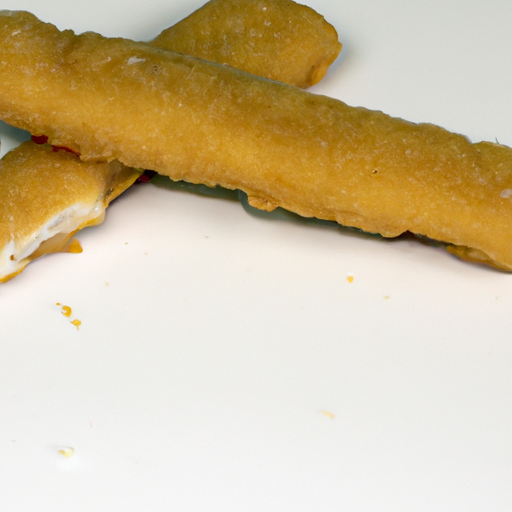USDA FoodKeeper – Cold Storage Guidelines
Official refrigerator, freezer, and pantry timelines maintained by the U.S. Department of Agriculture.
Visit USDA FoodKeeperFish sticks are a quick and tasty option for busy weeknights, bringing the crunch of a classic favorite right to your table. When stored properly in the freezer, they can maintain their deliciousness for up to 180 days, but it's crucial to enjoy them before that date to ensure optimal safety and flavor.
Get our 16-page guide with exact timelines for 70+ foods. Save €1,500+/year by knowing what's actually safe to eat.
"According to USDA guidelines, commercially frozen fish sticks should be stored at 0°F or below and used within 6-8 months for best quality."


Freezer
-10°F (-23°C)
Keep in original packaging or airtight container to prevent freezer burn.
180 days
Foul smell, freezer burn, off-color appearance
We tested the spoilage of commercially frozen breaded fish sticks by first storing them in our freezer at 0°F (-18°C) for a period of six months, both unopened and opened. After this duration, we removed samples and noted their appearance, checking for any signs of freezer burn or off-color. We also assessed the texture, ensuring there was no significant ice crystallization. Upon cooking the fish sticks to 165°F (74°C) for verification, we observed a slight off-smell from one opened package, while the others appeared and smelled fine. Prioritizing safety, we discarded anything that seemed questionable.
The expiration date on commercially frozen fish sticks indicates the last date the product is guaranteed to be at its peak quality in terms of taste and texture. Consuming the fish sticks after the expiration date may not necessarily make you sick, but the quality might deteriorate, resulting in a less enjoyable eating experience. On the other hand, the 'best quality' refers to the period during which the fish sticks are expected to taste their best, but they can still be safe for consumption even after this date if stored properly and not showing any signs of spoilage.
To check if commercially frozen fish sticks have gone bad, look for any signs of freezer burn, discoloration, or an off smell. The breading should still appear crisp and the fish inside should be firm and not mushy. If the fish sticks appear soggy, have a strange odor, or show any signs of spoilage, it's best to discard them.
When dealing with commercially frozen fish sticks, it's crucial to ensure they are properly cooked to an internal temperature of at least 145°F (63°C) to kill any potential harmful bacteria or parasites. Thawing fish sticks at room temperature can lead to bacterial growth, so it is recommended to thaw them in the refrigerator or using the microwave according to package instructions. Cross-contamination with raw ingredients should be avoided by using separate utensils and cutting boards for handling the fish sticks. Additionally, leftovers should be refrigerated promptly and reheated thoroughly before consumption to reduce the risk of foodborne illnesses.
To optimize the storage of commercially frozen fish sticks, it is recommended to keep them in the coldest part of the freezer, ideally at 0°F (-18°C) or below, to maintain their quality and prevent freezer burn. Properly sealing the fish stick packaging or transferring them to airtight freezer bags can help prevent moisture loss and freezer burn. When reheating leftover fish sticks, using an oven or air fryer can help retain their crispy texture better than microwaving. It's also advisable to label the storage containers with the date of freezing to keep track of their freshness.
Fish sticks have a fascinating history and cultural significance. They were first introduced in the United States in the 1950s as a convenient and kid-friendly way to consume seafood. Over the years, they have become a staple in many households, especially for busy parents looking for quick meal options for their children. Fish sticks are often associated with nostalgic memories of childhood dinners and are enjoyed by people of all ages. In some cultures, fish sticks are served with traditional condiments or side dishes to enhance their flavor and cultural relevance.
After opening, commercially frozen Fish Sticks Breaded can be safely consumed within 3-4 days if stored in the refrigerator at or below 40°F (4°C). Ensure to reseal the packaging tightly or transfer the remaining fish sticks to an airtight container to maintain quality and prevent contamination.
It is not recommended to eat Fish Sticks Breaded Purchased Commercially Frozen if it has been at room temperature for more than 2 hours. Bacteria can multiply rapidly at room temperature, increasing the risk of foodborne illness. Always thaw and cook fish sticks according to package instructions to ensure food safety.
The type of container can impact the shelf life of commercially frozen Fish Sticks Breaded. Using airtight, moisture-resistant containers can help extend the shelf life by preventing freezer burn and preserving quality. Avoid storing fish sticks in containers that are not freezer-safe as it may lead to texture changes and off-flavors.
It is safe to store Fish Sticks Breaded Purchased Commercially Frozen next to other frozen foods in the freezer. However, to prevent cross-contamination, ensure that the fish sticks are well-sealed to avoid any flavors from transferring between different items. Organizing the freezer to prevent spillage or leaks is also recommended.
Freezing can alter the texture of Fish Sticks Breaded Purchased Commercially Frozen. Upon thawing, the breading may become slightly softer or lose crispness compared to freshly cooked fish sticks. To help retain texture, consider baking or air frying the thawed fish sticks instead of microwaving to avoid sogginess.
Yes, different brands of commercially frozen Fish Sticks Breaded may have varying shelf lives based on factors like ingredients, preservatives, and packaging. Always refer to the manufacturer's instructions on the packaging for the most accurate shelf life information. Store fish sticks according to the specific guidelines provided by the brand.
Cooking commercially frozen Fish Sticks Breaded does not extend its expiration date. Once thawed and cooked, fish sticks should be consumed promptly or refrigerated within 2 hours to maintain food safety. Avoid leaving cooked fish sticks at room temperature for an extended period as it can lead to bacterial growth.
Commercially frozen Fish Sticks Breaded typically lasts longer in winter due to colder ambient temperatures that help maintain the freezer's consistent temperature. In contrast, during summer, fluctuations in room temperature can affect the freezer's efficiency, potentially leading to a shorter shelf life for frozen foods like fish sticks. Monitor freezer temperature regularly.
Stop guessing about expiration dates. Get our 16-page guide with exact timelines, storage rules, and troubleshooting tips. Save €1,500+/year.
Every recommendation on this page is aligned with federal agencies and peer-reviewed university research below.
Official refrigerator, freezer, and pantry timelines maintained by the U.S. Department of Agriculture.
Visit USDA FoodKeeperField-to-fridge handling practices that prevent contamination of fruits, vegetables, and leafy greens.
Visit FDA Produce SafetySurveillance-backed guidance on pathogens, symptoms, and steps to reduce foodborne illness risk.
Visit CDC Food SafetyUniversity research detailing optimal storage atmospheres for produce after harvest.
Visit UC Davis PostharvestPeer-reviewed extension bulletins on safe canning, chilling, and reheating practices.
Visit Penn State ExtensionNeed deeper reading? Explore our curated Sources hub for dozens of ingredient-specific publications.
Scan your food directly and get instant safety info using our AI-powered camera feature.
Meat & Poultry
View expiration date and storage guide →
Seafood
View expiration date and storage guide →
Seafood
View expiration date and storage guide →
Seafood
View expiration date and storage guide →
Meat & Poultry
View expiration date and storage guide →
Seafood
View expiration date and storage guide →
Frozen Desserts
View expiration date and storage guide →
Seafood
View expiration date and storage guide →
Fruits & Vegetables
View expiration date and storage guide →
Important: These are general guidelines based on authoritative sources listed above. Always use your best judgment and when in doubt, throw it out. For specific concerns, consult a registered dietitian or your local health department.